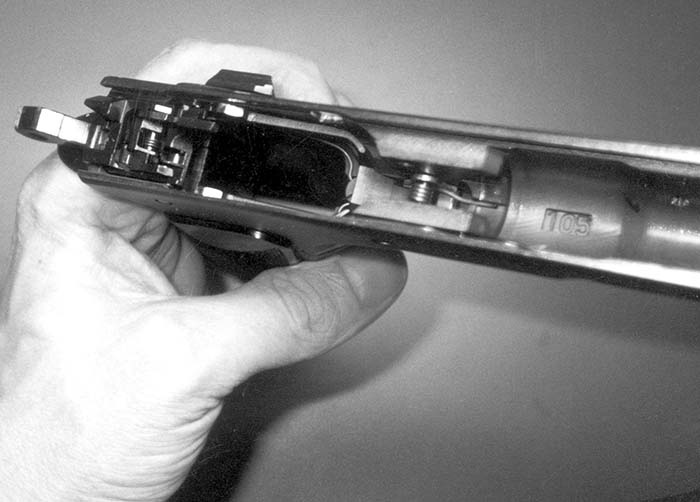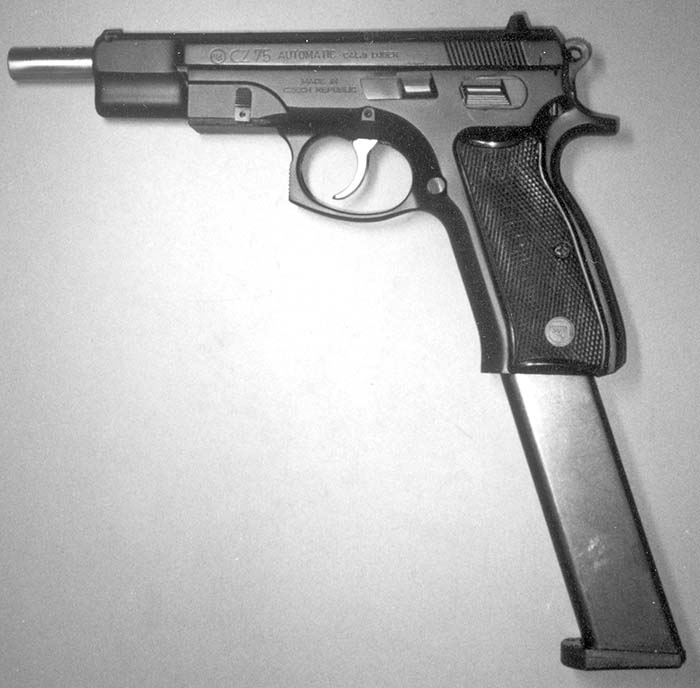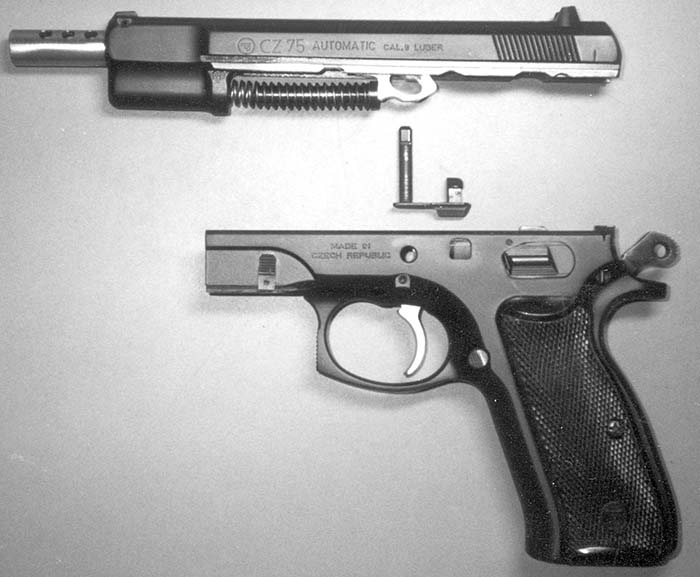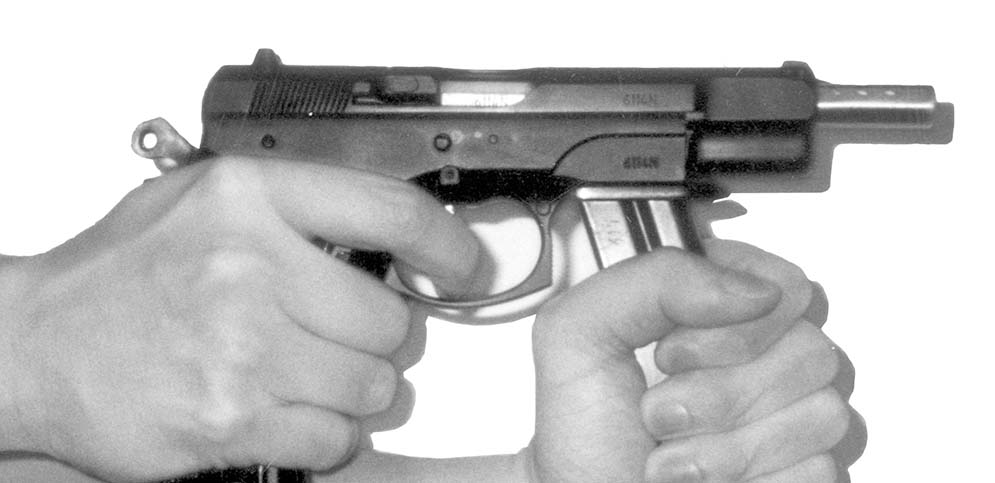By Robie Kulokivi
The well-known Ceska Zbrojovka CZ-75 service pistol from the former Czechoslovakia has a relatively new and surprising family member. Over the years the basic CZ-75 pistol model has slightly changed and improved technically. The country of origin has also met with some changes when the Czech and Slovak separated peacefully into two independent states. In spite of the CZ-75 improvements the pistol has remained as an economic option for service or sport with price and quality in good balance. The basic pistol has been produced and sold in notable quantities. There was, however, a need to extend sales to rather restricted niche markets of specialty weapons. In the middle of 1990 the factory started producing a selective-fire model of the CZ-75, a machine pistol was the new family member.
A retrospective look at the basics
Ceska Zbrojovka P.L.C. is a factory that has been producing military, law enforcement and sporting weapons in the city of Uhersky Brod for over 60 years, since 1936. The company has survived big and small changes over that time and today it specializes in precision mechanical engineering in several branches; aircraft and motor subassemblies, and tooling and weapons. Ceska Zbrojovka also has daughter firms in the USA and Slovakia.
The basic pistol model CZ-75 was noted in the west through different connections by the late 1970. It awoke the technical interest of western researchers due to the atypical approach of an “eastern-block” pistol during that colder time. The caliber was surprisingly the standard 9x19mm, not its eastern counterpart, and it had some special slide-related technical solutions. The construction designers were the engineer brothers Josef and Frantisek Koucky and they aimed at a product that would combine the central design requirements of professional pistol users. Some of the requirements for the new service pistol were; large capacity magazine, double action trigger, balanced steel construction and economical price. The special technical feature of the slide that got the attention of western gun writers and professionals was the arrangement of reversed slide rails. In effect this means that the upper frame slides within the lower frame. It is an approach seldom used in pistols but is possible in wide framed models.
The technical advantage in such an arrangement is open for debate but at least it gives a lower profile to the upper frame, or slide as it is called in a pistol. However in the CZ-75, the total ergonomic advantage is not taken, as it is not possible to place the hook of the thumb of the gripping hand as high up as the low frame would allow due to the fact that the pistol has an external hammer.

Many analysts found the CZ-75 a combination of the good features incorporated in such pistol designs as the Browning High-Power and the S&W M39. Especially the American gun writers found the internal machining unduly complicated but of relatively good quality. As the Czechoslovakian government of the time had enough service pistols for their military and police the sales efforts were export oriented. An export company named Merkuria found several end users in Central America and Scandinavia alike. All these volume sales and user feedback thereof were very important for the technical development of the basic model.
The basic CZ construction was later copied by several other gun producing companies as either direct clones like Swiss or Italian models, or as modifications like Israeli models. All of the pistol products based on the basic design have been popular. The original Ceska Zbrojovka factory still produces the CZ-75 in over ten different variations, from the compact model to a gunsmith-tuned IPSC competition model. The range of caliber include 9x21mm and .40S&W. An evolution model called the CZ-85 with an ambidextrous approach has found popularity in the sporting markets as an economical IPSC pistol.
One CZ-pistol model has received less public attention and this is due to the authority oriented specialty market. This small and fast paced selective-fire submachine gun, or machine pistol if you like, is based on the CZ 75B version of the standard pistol and is called 9x19mm CZ 75 Automatic.

Machine pistol or SMG
The terminology has been pondered upon before. Machine pistol gives us the impression of a service pistol-sized gun that delivers selective fire. On the other hand SMG (submachine gun) includes a larger amount of different weapon constructions offering full and semi-automatic fire and using service pistol calibers.
There has been a need to experiment with machine pistol constructions since the beginning of the modern self-loading pistol. Scrutinizing the more modern end of the history we can find products such as the H&K VP70, Beretta M93R or Glock-18 and all of these have found special applications by the authorities, police and military.
Perhaps it is not so surprising that Ceska Zbrojovka from Uhersky Brod brought their own small machine pistol to the market in the middle of 1990 to compete for these niche markets. As this small submachine gun is not equipped with a shoulder stock it should be compared to the Austrian Glock-18 machine pistol.
This CZ-modification shows practicality and sound technical solutions and it is clear that the project of design has had a suitable amount of resources to produce prototypes before the production series.
After initiating the project, the first selective-fire prototypes were made based on the newer CZ-85 ambidextrous model. The chief designer was Mr. Martin Kouba and the construction was presented at the 1992 IWA gunshow in Germany. This machine pistol design was not taken further and the basis for the next version was the CZ 75 pistol. Engineer Alexander Koten finished the actual CZ 75 machine pistol conversion during 1993 and after extended trials, production commenced with the marketing to military and police end users. This model was based on the modernized frame of the basic pistol and has been on the market since 1994, and aptly named 9x19mm CZ 75 Automatic sub-machine gun. Parallel to the prototype development of the CZ 75 Automatic Mr. Stanislav Strizik made a single-action selective-fire workshop prototype which, like the CZ-85 select fire was a project discontinued.
CZ 75 Automatic machine pistol
The CZ 75 Automatic is an all steel handgun. The barrel is hammered and machined, the slide and lower receiver are precision cast and machined. The trigger mechanism is double- and single-action. The user has the option of a first shot with either activating the hammer with the full double action press of the trigger or by cocking the external hammer and placing the selector on safe, for single action mode when needed. Even if the machine pistol has an external hammer it does not have a hammer release lever. This means that if the hammer is cocked it must be triggered and released under control of the thumb to place the gun in the double-action mode.

The locking mechanism of this pistol is no surprise as it follows the Browning principle of locking lugs on the barrel breech block connecting into recesses on the upper inner surface of the slide, when the slide is in its forward position. The connection is opened only after the short connected barrel-slide travels to the rear during the recoil cycle when a cartridge is fired. The breech end of the barrel is forced slightly down and stopped by the guiding pin, the connection unlocking letting the slide retract the full movement of its cycle. The force of the return spring slows its speed and eventually returns it to battery in its forward position. During the retracting movement of the slide the cartridge case is extracted and ejected and when the slide goes forward it forces the next cartridge from the magazine into the chamber.
This small CZ 75 Automatic machine pistol has at least two technical solutions that merit special attention;
- 1. The external arrangement of the selector. The safety switch situated on the left side of the pistol functions as the selector lever. It incorporates a simple feature that prevents any unintentional rotation into the full automatic position. When the selector is in its uppermost position (pointing 10 o’clock) the pistol is set on safe. When the selector is turned to the middle position, a very logical horizontal position pointing into the firing direction (9 o’clock) and showing one red dot the gun is set at semi automatic fire.
To place the selector lever into its lower position (8 o’clock) for cyclic fire the middle part of the lever must be first pressed in the firing direction to facilitate the downward movement of the selector. The lever has in effect to be pressed forward and downward, and in its lower position two dots are showing as a mark of full automatic fire mode.
For example, the Glock-18 machine pistol does not have any safety locking of its selector lever. The Glock selector, which is placed on the rear of the slide’s left side is safeguarded from accidental cyclic fire with a long movement of the selector switch. When in semi automatic mode the lever points at 11 o’clock and only turning it counterclockwise into the position 7 o’clock will facilitate full automatic fire. - 2. The spare magazine functions as the front grip. The front of the lower receiver has a machined rail, and on the left side a spring actuated small latch. The floorplates of the magazines have similar machined tracks as the rails in the frame and a small recess for the frame latch. If the machine pistol operator wants a substantially firmer grip for firing cyclic he can connect the reversed spare magazine from its floorplate to the underside of the lower receiver. This gives an ergonomic grip pointing slightly forward. The magazine is locked in place by the small latch. To release the magazine the latch has to be pushed upwards and the magazine slid off in firing direction.
In comparison the Glock-18 smg does not have a front grip and can not even facilitate one and the Beretta M93 smg has a small foldable front grip in the lower receiver.
Tryout at the range
The semiautomatic features of the CZ 75 Automatic are in par with any requirements of a standard service sidearm. The optional integrally compensated barrel offers slightly lesser recoil-movement of the gun but on the other hand the markedly higher gun report due to the gas ports, is not worth the gain. The compensated barrel has six openings in the front part of the barrel, they open up and to the sides, three on both sides. Personally, I favor the standard barrel giving a slightly shorter total length.
The sightspan of the open sights is 155 mm and they utilize a white three-dot system, with one dot in the bead and two on either side of the rear notch.
The cyclic rate of the machine pistol is approximately 22-25 cartridges per second. This rate is so high that it is hard to decide on sound if it was a single shot or a two-cartridge burst. During an extended burst the cartridges are positively ejected to the right of the gun. Cyclic firing with this weapon offers a lot of torque to the supporting hands. A double handed grip is always recommended, and the operator should connect the front grip if the firing distance exceeds 15 meters. If the range is 10 meters or less it is possible to keep all hits on a target area of 1x 0.5m. The hits are divided over the total area. After practice it is possible to keep the length of the bursts at 2-4 cartridges and this increases hit probability for longer ranges. The fifteen cartridge magazine seems too short for the novice practicing full automatic firing with the CZ-75 A, but to keep the running temperature of the gun at reasonable levels during training it is good practice to let the gun cool down. The risks involved having a gun that is too hot a the “cook-off” effect on a chambered cartridge. That happens when the temperature of the chamber area of the gun is so high that it transfers to the powder charge in the cartridge and ignites it. At the very least an overheated gun is mechanically under great stress and the normal lubrication evaporates. The optional magazine holds 25 cartridges.
The gun is easy to strip for standard maintenance. Remove the magazine and check the chamber and remove any cartridge. Pull the slide to the rear so that the slide and receiver marks (at the rear left side) meet. The slide stop is removed to the left by pressing at the end of its axle on the right side, and pulling it out of the lower receiver. Let the slide carefully to the forward position and pull it off the lower receiver. The return spring and its guide can be released from below the barrel, and the barrel pulled out of the slide down and to the rear. The gun can be assembled after cleaning in the reversed order.
As a machine pistol the CZ 75 Automatic is a very interesting, well-designed and technically reliable small submachine gun. It remains to be seen in which direction the Czech company Ceska Zbrojovka will take its newest prototype weapons. Perhaps there eventually will be something in the Belgian caliber 5.7x28mm.
Please see the article on the Semi-Auto CZ-75 in this issue by Frank Iannamico…
| This article first appeared in Small Arms Review V4N8 (May 2001) |











